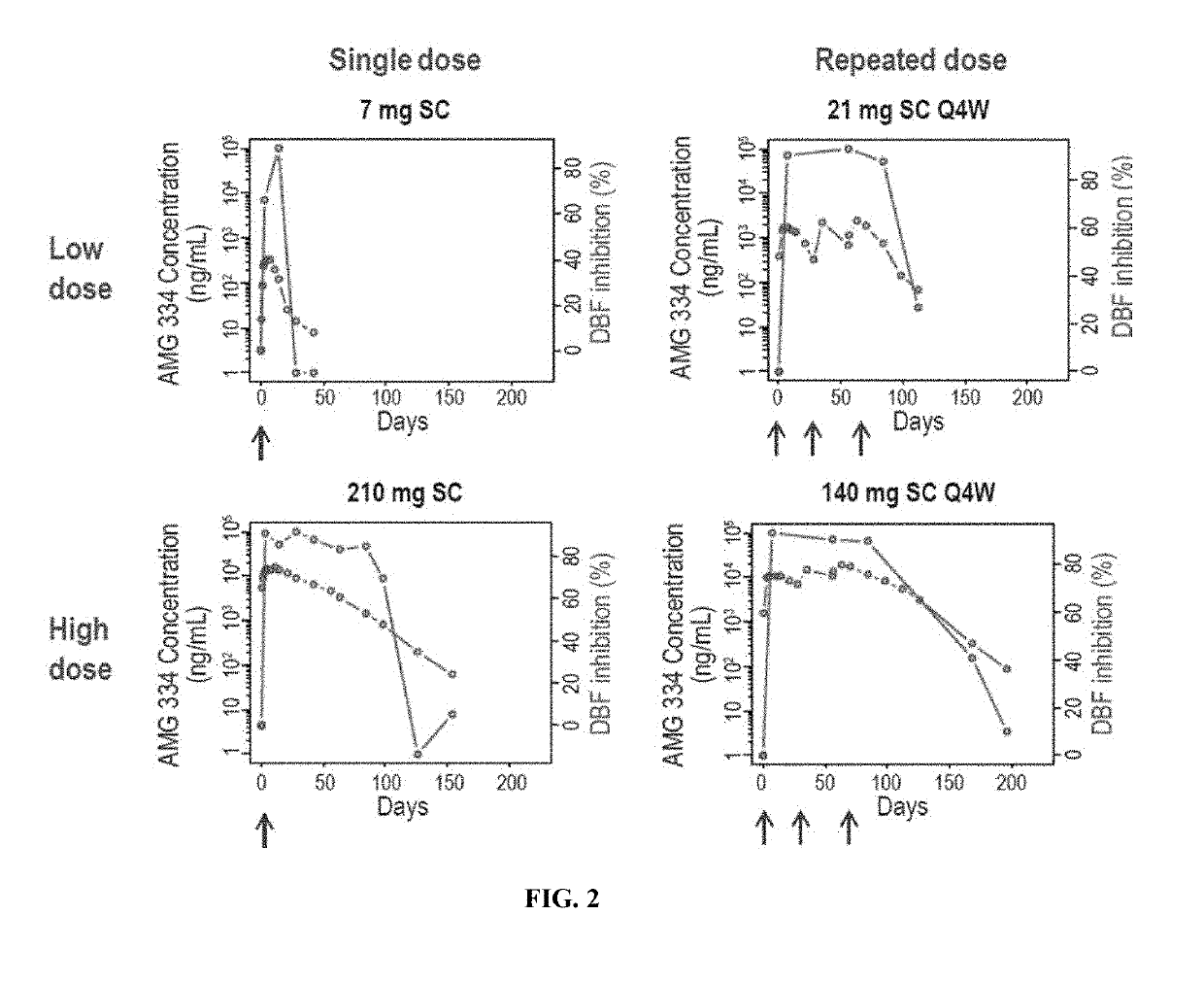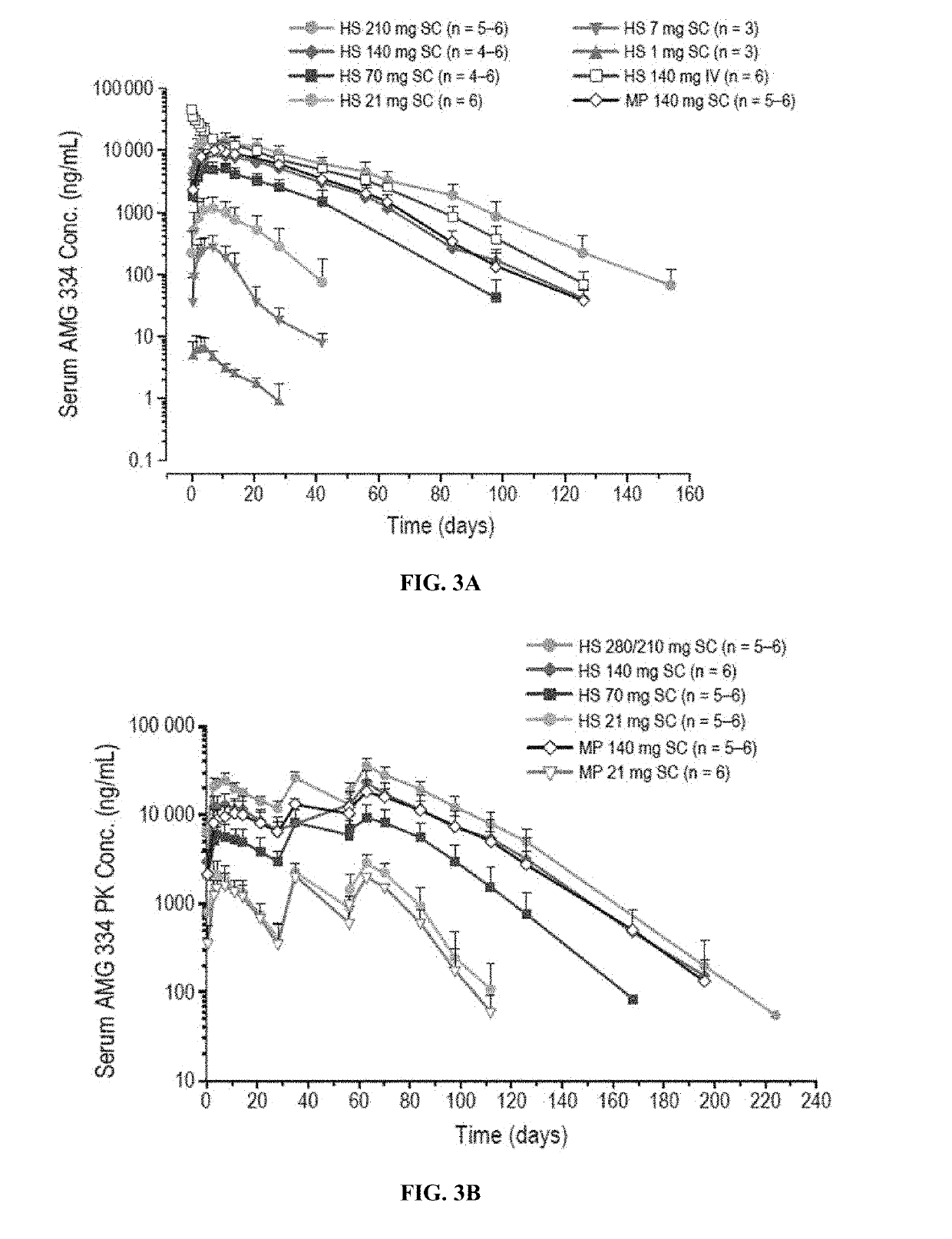Methods for treating or preventing migraine headache
a migraine headache and migraine prevention technology, applied in the field of neurology and biopharmaceuticals, can solve the problems of migraine headaches that are disruptive to daily life, migraine attacks may be unilateral, severe headache pain, etc., and achieve the effect of reducing the frequency, severity and/or duration of migraine headaches, and preventing or reducing the occurrence of migraine headaches
- Summary
- Abstract
- Description
- Claims
- Application Information
AI Technical Summary
Benefits of technology
Problems solved by technology
Method used
Image
Examples
example 1
inetic / Pharmacodynamic Modeling of Monoclonal Antibody AMG 334 to Characterize Concentration Relationship with Capasicin-Induced Increase in Dermal Blood Flow in Healthy Subjects and Migraine Patients
[0262]AMG 334 (also referred to herein as antibody 4E4) is a fully human IgG2 monoclonal antibody that binds to the human CGRP receptor with high in vitro potency. Inhibition of capsaicin (CAP)-induced increases in dermal blood flow (DBF) has been used extensively as a translational model to characterize the pharmacological effect of CGRP receptor antagonists. This validated model was used to characterize the pharmacological effect of AMG 334 and to quantify the inhibitory effect of AMG 334 on CAP-induced increases in DBF in healthy subjects (HS) and migraine patients (MP) after single and multiple doses of AMG 334.
[0263]The analysis dataset included 52 subjects (40 HS, 12 MP) who received a single subcutaneous (SC) dose of AMG 334 (1, 7, 21, 70, 140, or 210 mg) or placebo and 40 subjec...
example 2
Randomized, Double-Blind, Placebo-Controlled, Single-Dose and Multiple Dose Studies of AMG 334 in Healthy Subjects and Migraine Patients
[0267]Migraines are disabling headaches for which calcitonin gene-related peptide (CGRP) is thought to be involved. AMG 334 (4E4 antibody) is a fully human monoclonal antibody against the CGRP receptor. In these phase 1, randomized, placebo controlled, single-dose (SD) and multiple-dose (MD) studies, the pharmacokinetics (PK), pharmacodynamics (PD) and safety of AMG 334 in healthy subjects and migraineurs were evaluated.
[0268]In the SD study, subjects received single, escalating doses of AMG 334 (n=42) of 1 to 210 mg SC, 140 mg IV, or matching placebo (n=18). In the MD study, subjects received multiple doses of AMG 334 (n=35) of 21 to 280 mg SC or placebo (n=12) on days 1, 29, and 57. PK and safety were evaluated in both studies; PK measurements included maximum concentration (Cmax), area under the concentration-time curve from time zero to the last...
example 3
f a Randomized, Double-Blind, Placebo-Controlled, Phase 2 Study to Evaluate the Efficacy and Safety of AMG 334 for the Prevention of Episodic Migraine
[0276]In this phase 2, double blind, placebo-controlled trial, the effects of AMG 334 (i.e. 4E4 antibody) in preventing episodic migraine were evaluated.
[0277]Patients with episodic migraine (≥4 and ≤14 migraine days per month) were randomized to subcutaneous, monthly (QM) placebo or AMG 334 (7 mg, 21 mg, or 70 mg) in a 3:2:2:2 ratio, respectively. The primary endpoint was the change from baseline in monthly migraine days at week 12. Secondary endpoints included the proportion of subjects with ≥50% reduction in monthly migraine days (i.e. 50% responder rate), reduction in monthly migraine attacks, and safety / tolerability. Key exploratory endpoints included reduction in monthly headache days and monthly acute migraine-specific medication (e.g. triptans, ergotamines) use days.
[0278]483 subjects were randomized to placebo (n=160), AMG 334...
PUM
| Property | Measurement | Unit |
|---|---|---|
| volume | aaaaa | aaaaa |
| volume | aaaaa | aaaaa |
| dissociation constant | aaaaa | aaaaa |
Abstract
Description
Claims
Application Information
 Login to View More
Login to View More - R&D
- Intellectual Property
- Life Sciences
- Materials
- Tech Scout
- Unparalleled Data Quality
- Higher Quality Content
- 60% Fewer Hallucinations
Browse by: Latest US Patents, China's latest patents, Technical Efficacy Thesaurus, Application Domain, Technology Topic, Popular Technical Reports.
© 2025 PatSnap. All rights reserved.Legal|Privacy policy|Modern Slavery Act Transparency Statement|Sitemap|About US| Contact US: help@patsnap.com



